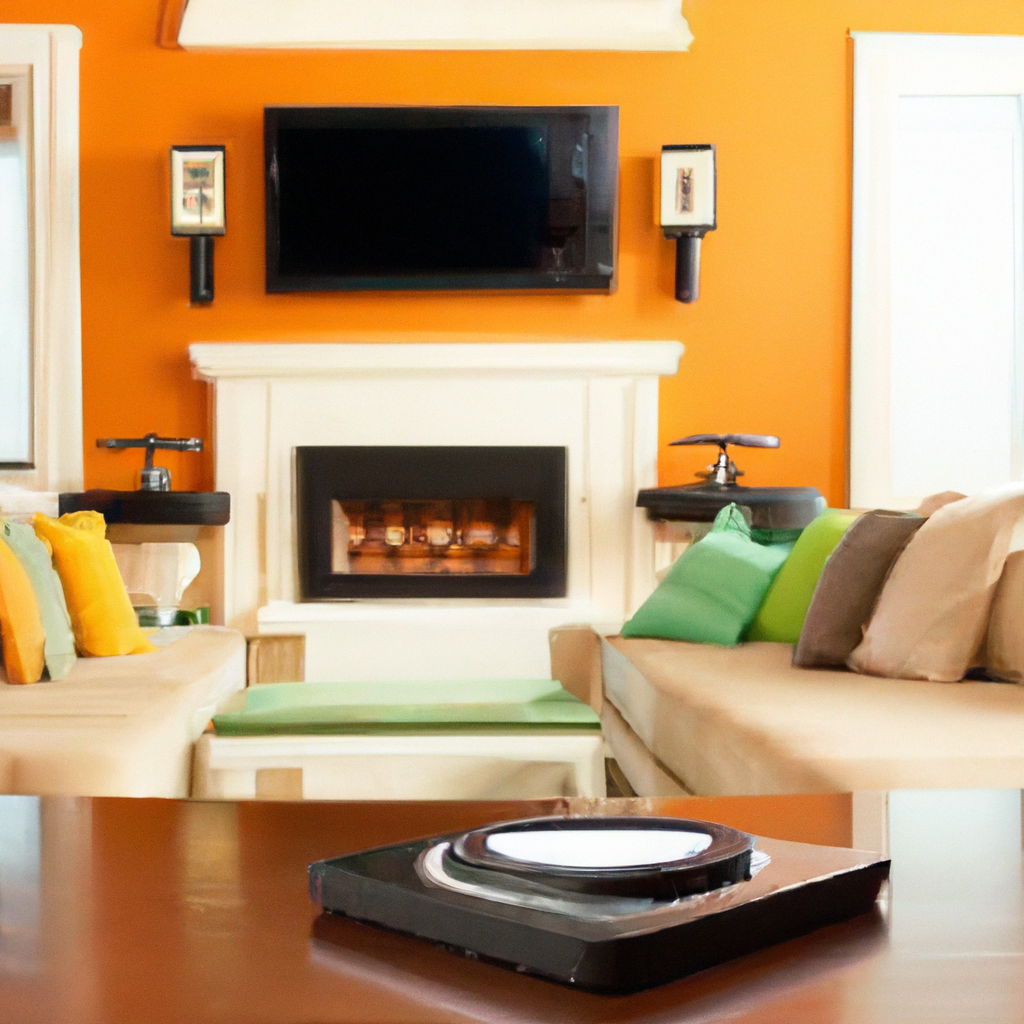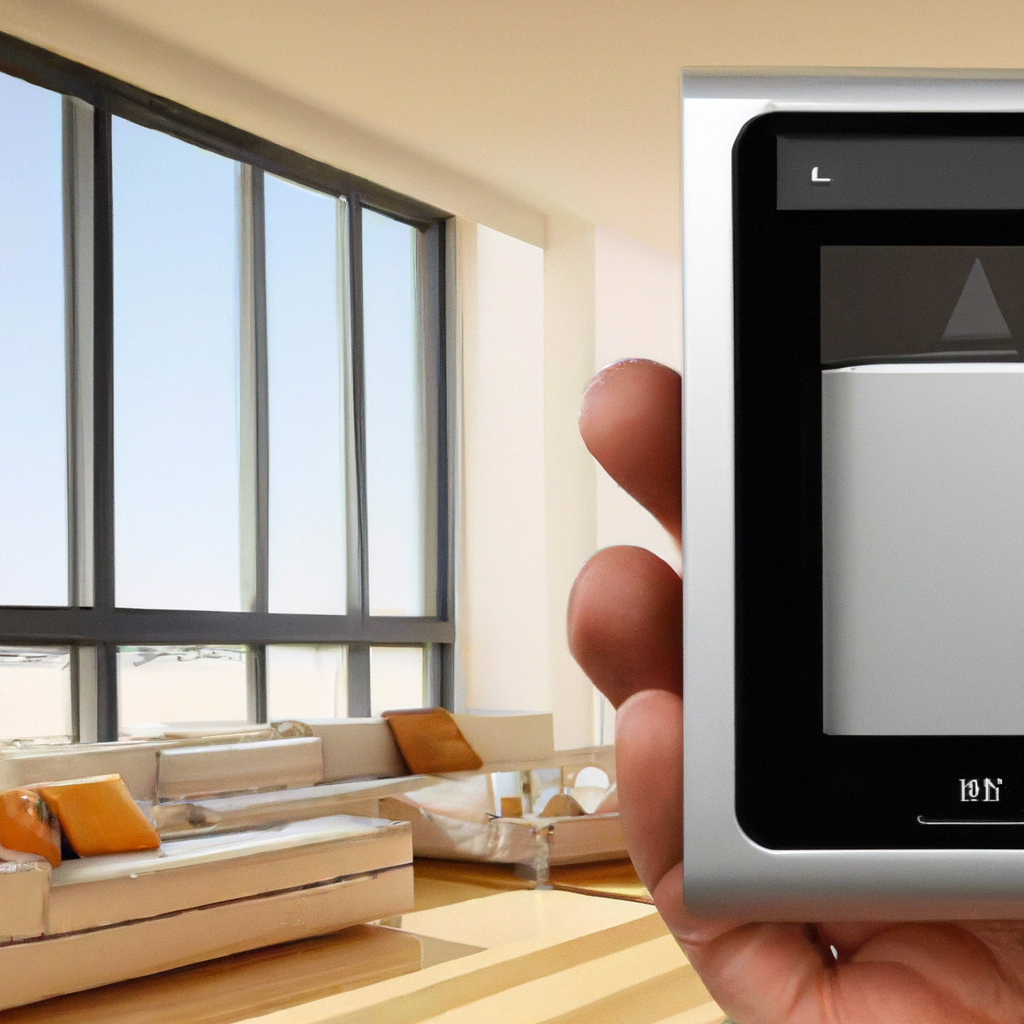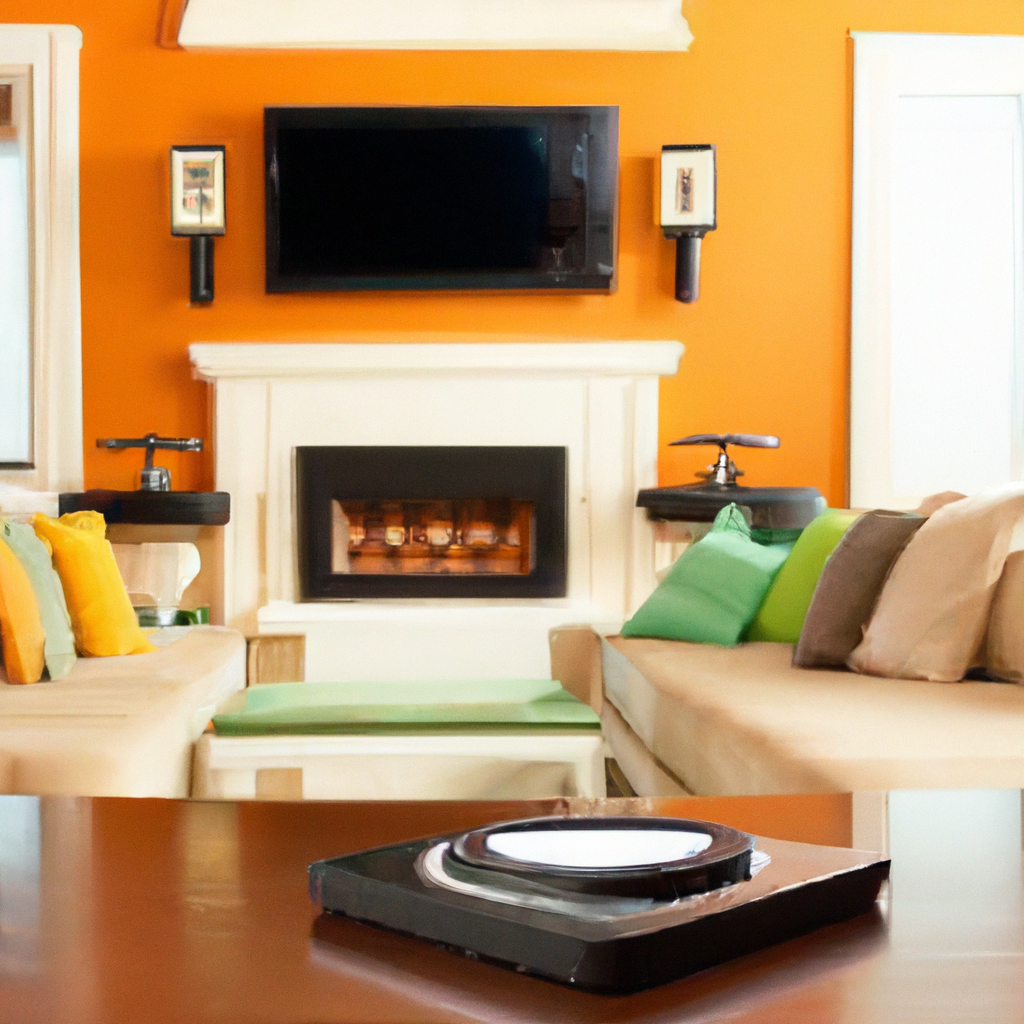Imagine stepping into your living room, where everything is seamlessly connected and working harmoniously to create a more sustainable lifestyle. From energy-efficient lighting that automatically adjusts to your preferences, to smart thermostats that optimize temperature control, and even smart appliances that reduce water and electricity consumption, a smart living room offers endless possibilities for living more sustainably. By integrating technology and automation, these smart living rooms not only offer convenience and comfort, but also play a significant role in reducing our carbon footprint and promoting a greener future.

Reducing Energy Consumption
Smart Thermostats
Installing smart thermostats in your living room can significantly reduce your energy consumption and contribute to a more sustainable lifestyle. These intelligent devices learn your temperature preferences and create customized schedules to optimize energy usage. You no longer have to worry about manually adjusting the thermostat as smart thermostats can automatically lower or raise the temperature when you’re away or asleep. This ensures that your energy consumption aligns with your needs, resulting in lower utility bills and a reduced carbon footprint.
Smart Lighting Systems
Optimizing your living room’s lighting with smart lighting systems is another excellent way to reduce energy consumption. These systems use energy-efficient LED bulbs and can be controlled remotely through smartphone apps or voice assistants. With the ability to program schedules, create lighting scenes, and adjust brightness levels, you can easily ensure that lights are only used when necessary. Additionally, motion sensors can automatically turn off lights when no one is present in the room, avoiding unnecessary energy waste.
Energy-efficient Appliances
Equipping your living room with energy-efficient appliances is a significant step towards sustainability. From smart TVs to sound systems, choose devices with energy-saving features that minimize electricity usage. Look for appliances with energy star ratings, as these are designed to consume less energy without sacrificing performance. By consciously selecting energy-efficient appliances, you not only reduce your electricity bill but also contribute to a more sustainable environment by decreasing the demand for power generation.
Optimizing Natural Light
Automated Window Coverings
Automated window coverings offer a convenient and sustainable solution for managing natural light in your living room. These smart shades or blinds can be controlled remotely, allowing you to close or open them depending on the daylight intensity or your preferences. By maximizing natural light during the day, you can reduce the need for artificial lighting and decrease energy consumption. Moreover, automated window coverings can also help regulate the temperature in your living room by blocking out heat from direct sunlight, reducing the load on your HVAC system.
Sensors for Natural Light
Incorporating sensors that detect natural light levels can further optimize your living room’s energy usage. These sensors can be connected to your lighting system, allowing the lights to automatically adjust according to the available natural light. When ample sunlight is detected, the sensor can either dim or completely turn off the artificial lights, minimizing energy waste. By harnessing the power of natural light and integrating it with smart technology, you can create a comfortable and energy-efficient living room.

Efficient Heating and Cooling
Smart HVAC Systems
Efficiently heating and cooling your living room is essential for both comfort and energy sustainability. Investing in a smart HVAC (heating, ventilation, and air conditioning) system can help achieve this goal. Smart HVAC systems adapt to your living habits and adjust the temperature based on your occupancy patterns, saving energy when the room is unoccupied. Through smartphone apps or voice commands, you can control your HVAC system remotely, ensuring that it’s only active when needed. By using energy more effectively, you can reduce both your carbon emissions and utility bills.
Zoning and Occupancy Sensors
Integrating zoning and occupancy sensors in your living room can provide precise control over heating and cooling in different areas. Zoning allows you to divide your living room into designated zones, each with independent temperature controls. With occupancy sensors, the HVAC system can detect when a zone is unoccupied and automatically adjust the temperature accordingly. By efficiently managing heating and cooling based on occupancy and individual comfort, you can eliminate energy wastage and optimize energy consumption.
Reducing Water Waste
Smart Water Management Systems
To promote a sustainable lifestyle in your living room, incorporating smart water management systems is crucial. These systems monitor water usage, detect leaks, and offer valuable insights to help you reduce water waste. With real-time data available through smartphone apps, you can track your water consumption and identify areas where you can make improvements. Many smart water management systems also provide automatic shut-off features, preventing excessive water usage and potential damages caused by leaks. By actively managing your water consumption, you can conserve this precious resource and contribute to a more sustainable future.
Water Leak Detection
Water leaks not only waste a valuable resource but also contribute to higher water bills and potential property damage. By installing water leak detection systems in your living room, you can promptly identify and address any leaks. Smart leak detectors use sensors to detect abnormal water flow, notifying you through smartphone alerts or audible alarms. With early detection and quick repair, you can prevent excessive water waste and save money in the process. By actively addressing water leaks, you support sustainability efforts and ensure the efficient use of water resources.

Minimizing Food Waste
Smart Refrigerators
Smart refrigerators can revolutionize how you manage food in your living room, minimizing waste and promoting sustainability. These intelligent appliances can track the items in your fridge, monitor their expiration dates, and suggest recipes based on the ingredients you have. Furthermore, many smart refrigerators have built-in cameras, allowing you to remotely view the contents of your fridge while you’re grocery shopping. This feature helps prevent duplicate purchases and reduces the chance of food going bad before it gets consumed. By efficiently managing your food inventory, you can significantly reduce food waste and contribute to a more sustainable lifestyle.
Smart Kitchen Appliances
In addition to smart refrigerators, incorporating other smart kitchen appliances can further minimize food waste. Smart ovens, for instance, offer precise cooking temperature settings and automatic timers, ensuring that your food is cooked to perfection. By avoiding overcooking or burning meals, you can salvage more leftovers and reduce the need for food disposal. Smart kitchen scales and storage containers can also track the freshness of food and provide reminders to use them before they spoil. With these tools, you can better manage your food resources and minimize waste in your living room.
Inventory Management Systems
Implementing inventory management systems can streamline food organization and help reduce waste in your living room. These systems use barcode scanning or voice recognition to log items as they are added or consumed. With real-time inventory tracking and expiration date reminders, you can easily identify items that need to be consumed before they expire. By optimizing your food inventory and reducing the chances of food going to waste, you not only save money but also contribute to a more sustainable lifestyle.
Promoting Recycling and Waste Management
Smart Waste Bins
Smart waste bins provide an effective way to streamline waste management in your living room. These bins often have compartments for different types of waste, making recycling and sorting effortless. Additionally, some smart waste bins have sensors that automatically open the lid when it senses your hand’s proximity, promoting a hygienic and convenient waste disposal process. By encouraging proper waste separation and recycling in your living room, you contribute to reducing landfill waste and promote the reuse of valuable resources.
Recycling Sorting Systems
To make recycling even more efficient, consider integrating recycling sorting systems into your living room. These systems utilize advanced technology, such as artificial intelligence and robotic sorting arms, to categorize different types of recyclable materials automatically. By automating the sorting process, you can ensure accurate separation of glass, plastic, paper, and other recyclables with minimal effort. This helps increase recycling rates and reduces the contamination of recyclable materials, ultimately leading to a more sustainable waste management process.

Enhancing Indoor Air Quality
Smart Air Purifiers and Filters
Improving the indoor air quality of your living room is vital for a healthy and sustainable living environment. Smart air purifiers and filters can help achieve this by efficiently removing pollutants, allergens, and contaminants from the air. These devices use sensors to detect air quality levels and automatically adjust their filtration settings accordingly. With the ability to be controlled remotely, you can monitor and improve your living room’s air quality even when you’re away. By reducing indoor air pollution, you promote a healthier lifestyle while minimizing the energy consumed by your HVAC system.
Air Quality Monitoring
Integrating air quality monitoring systems provides valuable insights into your living room’s air composition and helps you take appropriate actions. These systems measure various factors such as particulate matter, volatile organic compounds (VOCs), humidity, and temperature. With real-time data and alerts, you can proactively manage your living room’s air quality. By identifying potential concerns, such as high pollen levels or excessive humidity, you can adjust your ventilation systems or take specific actions to maintain a healthy environment. By prioritizing clean air, you foster sustainability and support the well-being of both yourself and the planet.
Sustainable Furnishings and Materials
Eco-friendly Furniture
Opting for eco-friendly furniture in your living room contributes to a more sustainable lifestyle. Look for furniture made from sustainably sourced materials, such as responsibly harvested wood or recycled materials. Additionally, choose pieces that are built to last, reducing the need for frequent replacements and minimizing waste. Sustainable furniture also often incorporates non-toxic finishes and adhesives, ensuring a healthier indoor environment. By selecting eco-friendly furniture, you support sustainable production practices and create a greener living space.
Non-toxic Materials
When designing or renovating your living room, consider using non-toxic materials for painting, flooring, and other surfaces. Traditional paint, for example, often contains harmful volatile organic compounds (VOCs) that can negatively impact indoor air quality. Opt for low-VOC or zero-VOC paints instead, which are safer for both your health and the environment. Similarly, choose flooring options made from natural and sustainable materials, such as bamboo or cork. By consciously selecting non-toxic materials, you create a healthier living environment while minimizing the ecological footprint associated with traditional building materials.
Sustainable Fabrics
Selecting sustainable fabrics for upholstery, curtains, and pillows in your living room can significantly contribute to a greener lifestyle. Look for textiles made from organic, recycled, or upcycled materials. Sustainable fabrics often utilize environmentally friendly production processes, such as low-water consumption or natural dyeing methods. Additionally, choose fabrics that are durable and long-lasting, reducing the need for frequent replacements. By opting for sustainable fabrics, you support ethical and eco-conscious practices in the textile industry and help reduce the environmental impact of your living room.

Monitoring and Analyzing Energy Usage
Energy Consumption Dashboards
To gain a comprehensive understanding of your living room’s energy usage, utilize energy consumption dashboards. These dashboards provide real-time data and visualizations of your energy consumption, allowing you to identify areas where you can make improvements. By monitoring the energy consumption of various devices and appliances, you can make informed decisions about reducing usage or replacing energy-intensive equipment. Energy consumption dashboards empower you to take control of your energy usage and promote a more sustainable living room.
Smart Meters
Smart meters offer precise monitoring of your living room’s energy consumption by measuring electricity usage in real-time. These meters provide valuable insights into your energy consumption patterns, helping you identify high-consumption periods or devices. With this information, you can adjust your habits or make informed decisions about upgrading to more energy-efficient appliances. Smart meters also eliminate the need for manual meter readings, making the billing process more accurate and convenient. By utilizing smart meters, you actively participate in energy conservation and contribute to a greener living room.
Integrating Renewable Energy Sources
Solar Panels
Integrating solar panels into your living room’s energy system enables you to harness clean and renewable energy from the sun. By converting sunlight into electricity, solar panels reduce your reliance on fossil fuels and decrease your carbon footprint. Solar energy can be used to power your lighting, appliances, and other electrical devices, allowing you to operate sustainably. Furthermore, surplus energy can be stored in batteries or fed back into the grid, contributing to the overall renewable energy supply. By embracing solar power, you actively support the transition to a greener and more sustainable energy future.
Smart Grid Integration
Integrating your living room’s energy system with the smart grid can further enhance your sustainability efforts. The smart grid is an intelligent power distribution network that optimizes energy usage and incorporates renewable energy sources. By connecting your energy system to the smart grid, you can benefit from dynamic pricing, which incentivizes energy consumption during off-peak hours when renewable energy generation is high. This allows you to save money while promoting the use of renewable energy. Additionally, smart grid integration enables load balancing, ensuring a more stable and efficient electricity grid. By embracing the smart grid, you actively participate in shaping a sustainable energy ecosystem.
In conclusion, smart living rooms offer numerous opportunities to contribute to a more sustainable lifestyle. By adopting energy-efficient technologies, optimizing natural light, reducing water waste, minimizing food waste, promoting recycling and waste management, enhancing indoor air quality, selecting sustainable furnishings and materials, monitoring energy usage, and integrating renewable energy sources, you can create a living room that aligns with your environmental values. By making conscious choices and utilizing smart technology, you can enjoy a comfortable and sustainable living space while reducing your ecological impact. Embrace the power of smart living rooms and be a part of the sustainable future we all strive for.
